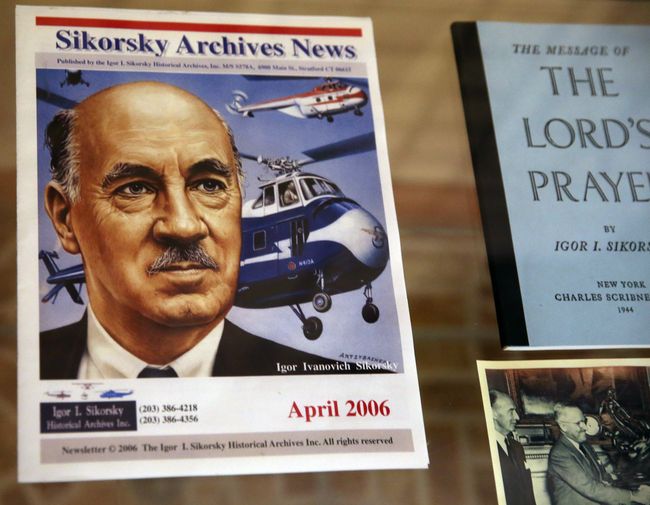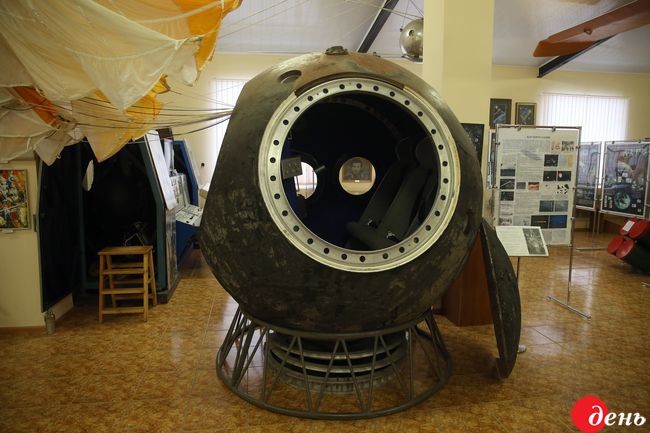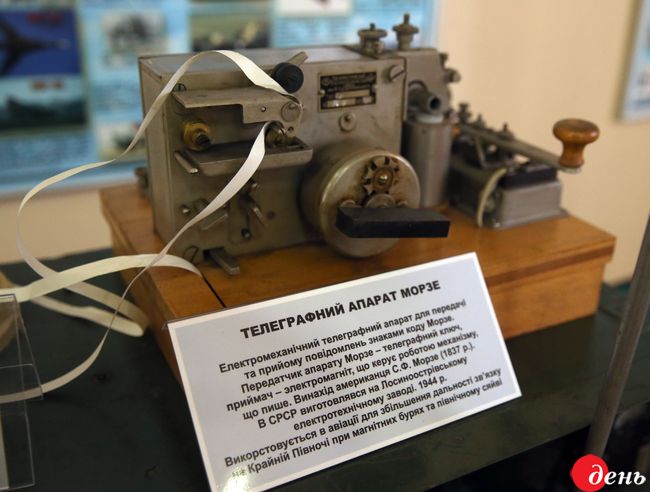“Our engineers were winners in the terrible 20th century”
Natalia Pysarevska tells how technical museums help the society to develop
At the beginning of the year, a super-modern Center for Science and Technology opened in the Polish city of Lodz. According to the Ukrainian service of the Polish Radio, it is located in a restored historic power plant and offers more than 150 interactive and multimedia devices and exhibitions. In general, Poland can be proud of its centers of science. It is enough to mention the Copernicus, where the author of these lines failed to get in because of huge queues.
“Technical museums belong to the category of museums that do not exist in Ukraine,” says Natalia Pysarevska, the director of the State Polytechnic Museum. It is a paradoxical situation for a country whose engineers have changed the world. The museum itself is part of the Sikorsky KPI University and  was founded in 1998 by the school’s leadership, scientists of the National Academy of Sciences of Ukraine and with the participation of the nation’s large enterprises. Its collection includes over 17,000 exhibits! “We have all the iconic devices of the 20th century,” Pysarevska added. Here one can see a radio receiver of 1917 vintage, a Neyron – one of the first personal computers, and the landing module of the Vostok 4 spacecraft. Moreover, development of many of these devices involved students and teachers of the KPI.
was founded in 1998 by the school’s leadership, scientists of the National Academy of Sciences of Ukraine and with the participation of the nation’s large enterprises. Its collection includes over 17,000 exhibits! “We have all the iconic devices of the 20th century,” Pysarevska added. Here one can see a radio receiver of 1917 vintage, a Neyron – one of the first personal computers, and the landing module of the Vostok 4 spacecraft. Moreover, development of many of these devices involved students and teachers of the KPI.
The museum’s director is devoted to her work. She enthusiastically talks about technical museums of other countries and the ways in which, despite the difficulties, she wants to change the Kyiv institution. She also explains why technical museums often appear in depressive times and how they help to change society. Now, let us listen to Pysarevska’s direct speech.
“THE FIRST TECHNICAL MUSEUM APPEARED IN PARIS DURING THE FRENCH REVOLUTION”
“Traditionally, technical museums were created after exhibitions which demonstrated technology achievements to the world. The first museum was founded along these lines after the Great Exhibition of the Works of Industry of All Nations of 1851, and it is located in London. Its appearance refuted the view that museums exist for the chosen few, for the rich. Suddenly, ordinary public started attending this museum in throngs, people got interested.

“Overall, the first technical museum was opened in Paris, during the French Revolution, simultaneously with the Louvre. Almost 230 years ago, Abbe Gregoire, who proceeded from the ideas of the philosopher, mathematician, and physicist Rene Descartes, proposed to create a kind of encyclopedia that could operate in accordance with the ideas of the Enlightenment: ‘We must enlighten ignorance which does not know, and poverty which has no means of knowing.’ Today it is the Musee des Arts et Metiers, located in the former monastery of Saint-Martin-des-Champs in Paris. As soon as a society becomes willing to educate its citizens, it opens such museums.”
THE WORLD’S NOISIEST MUSEUM
“Polytechnic museums have disproved the preconception that a museum can serve only for aesthetic pleasure. Another technical museum, important in terms of organization and public interest, exists in Munich. It has a long name, but throughout the world it is known as the Deutsches Museum. It is 19 kilometers long. The institution was created by electric engineer Oskar von Miller in 1906 as the Museum of Masterpieces of Science and Technology, and is still one of the most popular in the world.
“After the museum in Munich, I would like to mention the Chicago one. It was built during the Great Depression, after the visit of American entrepreneur Julius Rosenwald to Munich. Surprisingly, polytechnic museums appear in very difficult years for the host nation, when people want to change life in the country. In Chicago, Rosenwald endowed the museum to the tune of three million dollars with the sole condition that visitors be allowed to touch things and make noise. Now it is called the world’s noisiest museum.

“Science is developing very rapidly, and many people do not understand how this is happening. Frank Oppenheimer, brother of one of the developers of the atomic bomb, created another technical museum in the US after the Second World War – the Exploratorium in San Francisco. It was founded so that people knew about the opportunities offered by science and were not afraid of it. There is always a lot of noise and are long queues there, and one can obtain knowledge without feeling forced to. Having gone downhill along the hypotenuse, a child will forever remember what it is. Meanwhile, at the Museum of Science and Technology in San Jose, one can use a computer program to design a home that will withstand an earthquake.
“Probably, all these technical museums can be compared to ours, because they were created by scientists, with the help of university teachers and students.”
“TECHNOLOGIES TURN INTO EXHIBITS”
“Some newer museums have no collections as we are used to, as they present technologies. This applies, for example, to Chinese museums. Perhaps this will be the next stage in the development of such institutions.
“There are also institutions that are more like research centers. They tell people about science, but do not have their own collections. For instance, the Experimentanium and Water Information Center in Kyiv are like that.

“But even in technical museums that were created following exhibitions, the exhibits eventually become obsolete. As progress moves at a colossal pace, these things become historic exhibits very quickly. In the Japanese Miraikan, which is also called the Museum of Emerging Science and Innovation, the most up-to-date robots quickly become such exhibits.”
THE MUSEUM DOES OUTREACH WORK
“We need technical museums to move forward. In developed Australia, too, it is believed that the population should be enlightened. There is a specially equipped car there which enables educators to go to the most remote parts of the country and tell about various sciences: chemistry, physics, astronomy. Similar projects exist in Malaysia and Thailand.
“Speaking of developing countries, they have created an aircraft museum in Nepal inside the Boeing that was the first to land on a local airfield. We know little about Iran, but local astrophysicists have created a wonderful observatory. A beautiful public museum-observatory exists in Mexico, and they have strong museums there in general. The local Anthropology Museum in Tacuba, which is a slum area in Mexico City housing 43,000 residents, many of them illiterate and unemployed, helps to solve social problems, such as domestic violence and education of children.”
“TO HAVE TRUE DRIVE, ONE NEEDS A LOCATION, AMENITIES, AND FUNDS”
“Our museum is a university one, and the only technical museum as well. No art designers were involved with us, whose participation is very important, as shown by their work in the Museum of Cosmonautics in Zhytomyr and the Kyiv Chornobyl Museum. What we have is rather a public-access collection, because to have true drive, one needs a location, amenities, and funds. But I do not regret my fate, because the museum will soon turn 20, it was created in a difficult time and without government support, solely by the will of the KPI and the National Academy of Sciences. And neither the first computer, nor the tube receiver No. 1, made in 1917, can be seen anywhere else.

“Since we are a unit of the university, we carry out research tasks. We work on scientific topics, tell visitors about the KPI, receive up to 75 delegations from around the world every year. Early-year students and schoolchildren come to visit us. Our museum is different from others founded by universities due to its accessibility. We are open and free. The only problem is that we work on the university’s schedule: the museum is generally open on weekdays, but opens on weekends only if a tour has been ordered.”
A FESTIVAL OF STEAMPUNK AND TALK SHOW
“We are trying to get in touch with everyone who wants it. Last year, we hosted a great steampunk festival called the KyivSteamCon. People who like the Victorian age gathered here, it lasted a whole day. There were various games, science fiction writers and creators of comics presented their works, the museum held lectures on balloon aerostats, the Morse code, the history of the plastic film, and so on. We hosted the TEDxKPI conference three times, and now meetings of the OSA intellectual club are held here in the format of the Open Dialogs talk show which invites interesting people. Therefore, while being unable to create a true drive through our exhibits, we try to attract the audience differently, through communication about the new things with outstanding people.

“The fact that we are constantly in contact with the youth adds optimism. Because studying at the KPI is hard work, but those who survive the first and second years manage then to work and be active at the same time. To cite an example of this, a lot of winning projects in Kyiv City’s citizen budget competition were developed by students of the KPI. Our museum also submitted a project to the citizen budget competition, but we did not win. However, we have learned a lot, so we will do it again. We will submit a project to get funding to equip the museum with interactive equipment.”
“PEOPLE BRING US A LOT”
“Over 20 years of the museum’s existence, we have assembled well-thought-out collections. For example, we have ones of radio receivers, photographic equipment, television equipment, military communication equipment, aircraft engineering. We cannot afford to buy exhibits, but people bring us a lot. And, like nobody, we see how the world is changing.
“By the way, our department of cosmonautics is a bit unique. This collection was assembled by veterans of the cosmodromes in Baikonur, Plesetsk, and Kapustin Yar. These people spent their lives doing this work. There is currently a new wave of interest in space topics, and our department of cosmonautics has impressive exhibits. The head of that department Oleksandr Boltenko is the former head of the cosmonauts training department at Baikonur; he spent 20 years seeing cosmonauts off on their flights.”
“FOREIGN MUSEUMS SEND DISTRESS SIGNALS AS WELL”
“The KPI is not legally allowed to finance us. The museum was transferred to the management of the Kyiv City State Administration, but it only pays our salaries, as we are a separate structural unit of the KPI. Meanwhile, the KPI may not allocate anything to us, because we are considered to be a cultural institution. This issue has existed for three years. I have to do fundraising, look for money. But this is not just about us. I see that foreign colleagues send distress signals from time to time as well. For example, the American Metropolitan Museum is introducing a fixed entry fee.

“We are approaching a time when, if the society does not need you, you will not exist. What is happening with technical museums in Ukraine is a complete shambles. We have over 17,000 exhibits and over 1,200 square meters of area. But we are a mere university museum, and there is no great national institution. In China, for example, such museums are funded by everyone: city authorities, universities, communities, philanthropists, powerful donors, and big business.
“There is an early-stage project to create a museum of science in Kyiv, in the so-called Flying Saucer building near Lybidska subway station. It is difficult to deal with private businesses, but we will hope for the best.”
“OUR MISSION IS TO TELL THE ENGINEER’S STORY”
“For the Book Arsenal festival, we submitted seven volumes of academic lectures which we have held for many years. They tell the stories of 54 people who changed the history of technology... And there was no interest in these publications. Just like in the 1990s, crime stories dominate every media outlet, and I see journalists’ work as highly questionable.
“We in the museum are now approaching the problem of telling the engineer’s story. These people were winners in the terrible 20th century with its repression, famine, and wars. Unfortunately, our Ukrainian politicians are losers. When talking to students, it is difficult for us to explain why, say, Symon Petliura was a hero. He did not succeed in anything, after all. And then, there is a whole galaxy of people, who, despite the adverse circumstances, succeeded in everything and benefited humanity. One of them was Yuri Kondratyuk, whose grave we have not managed to locate yet. It was his designs that the Americans used to chart a trajectory of flight around the Moon. Or look at mechanic Stephen Timoshenko. Presidents of all divisions of Boeing came to the KPI and pressed Timoshenko’s books in Russian and English to their chests. They told us that if not for his work, their Boeings would not fly. At first, Timoshenko studied in Moscow, then became the youngest-ever professor at the KPI. He left this country in a terrible time. His quest for professional success was not easy and took him everywhere. And in the end, he educated a galaxy of successful students in America.

“Also, these people could change themselves. They knew that at any age, one could be a successful person, do what one likes. Yevhen Paton had been designing bridges until he turned 60-odd, and then started his work on welding. The Paton Bridge is a beautiful manmade monument to him.”
“TWO THIRDS OF THE WORLD PLOWED THE LAND USING TRACTORS DESIGNED BY OUR GRADUATE”
“There is a monument to mathematician Mykhailo Kravchuk on the university’s premises. In general, the Ukrainian mathematical school is extremely interesting and you will not hear this beautiful Ukrainian language spoken by our mathematicians anywhere else. There is a whole culture of language involved. Speaking of mathematics, it was Kravchuk who brought Ukraine to the level of international conferences. He looked like a dandy in the 1930s, wearing white trousers and a white canvas jacket. He discerned Sergei Korolev’s talent when the latter studied here. Kravchuk jumpstarted many people’s careers. For example, he helped Arkhip Lyulka, whose monument also stands here. He was a totally ordinary lad from the Bohuslav raion of the Kyiv oblast, and he went on to create such great aircraft engines! In Russia, 40,000 people worked at factories that made his engines. Still, the Lyulka Design Bureau has not managed to make anything of value since his death.

“Meanwhile, Kravchuk was arrested in 1938 based on a denunciation. His graduate students came out in his defense. The scientist was sent to a forced labor camp in the woods of the Kolyma region, where he worked hard. His grave has not been located. Still, I cannot say that he was not a winner. He brought Ukraine to a certain level, and it has been preserved in the mathematical culture of the world.
“Two thirds of the world plowed and harrowed the land and harvested the crops using tractors designed by our graduate Ivan Drong. The Minsk Tractor Plant produces these designs. There are so many such names, and we talk about them, but the public is not interested. The share of negativity surprises me.
“Today, there are no heroes who would be equally admired in all parts of Ukraine, except perhaps for Taras Shevchenko and the Cossacks. And it is very bad that we do not talk about the technical elite of Ukraine to counteract this. These people did a lot, they were successful, and nobody would oppose either the Paton Bridge or the tractor.”
“UKRAINE HAS LOST THAT BALANCE WHICH ALLOWS PEOPLE TO MAINTAIN DIGNITY”
“Since a few years, the creation of museums has actually been banned in Ukraine. The only exception is the plan to build the Maidan Museum, and I have nothing against it, I like the people who are creating it so that we have a place where one can remember and relive the past. And creating such a museum is very difficult, because the Maidan story is going on, and it is hard to evaluate what is happening right now. It can be a museum of memory, yes. Speaking of myself, I cannot remember a more terrible and wonderful time in my whole life. But if we want to develop, then we have to cry once and go on.
“I am astonished by the authorities’ reluctance to show our public how colorful is the world we live in, what our place in it is, what we can be proud of, and where we are moving. In China, for example, technical and natural museums exist in order to attract young people and discover the most talented of them, to give them an opportunity to study. In this country, meanwhile, the balance has been lost that allows people to maintain dignity in such a difficult time. Society needs such antidote precisely in the dark times, therefore, creating educational museums as opposed to political ones is a logical step. It is a pity that this is not a priority for our state.”
“TECHNICAL MUSEUMS RESTORE THE BALANCE”
“Many private museums of technology have emerged lately, the interest in such things is there. A public technical museum is direly needed in Ukraine. In many countries, people say that our engineering school is very respected, that we have made an incredible contribution to the world. We, meanwhile, cannot show it off as it should be shown.
“The most difficult task now concerns historical museums. Interpreting contemporary history from one perspective is wrong, but interpreting it from different perspectives is unworkable. No museums tell people about contemporary history in Serbia and France. Also, one has to know a lot to be able to perceive information in such a museum, because without having one’s own perspective, one can unwittingly borrow someone else’s. And people need some ground to stand on. Therefore, technical museums restore the balance.
“By the 20th anniversary, we will change everything. Our goals are to develop a strategy and learn how to earn money. I think we will tell people about the future. I am semi-optimistic. We will move forward.”






